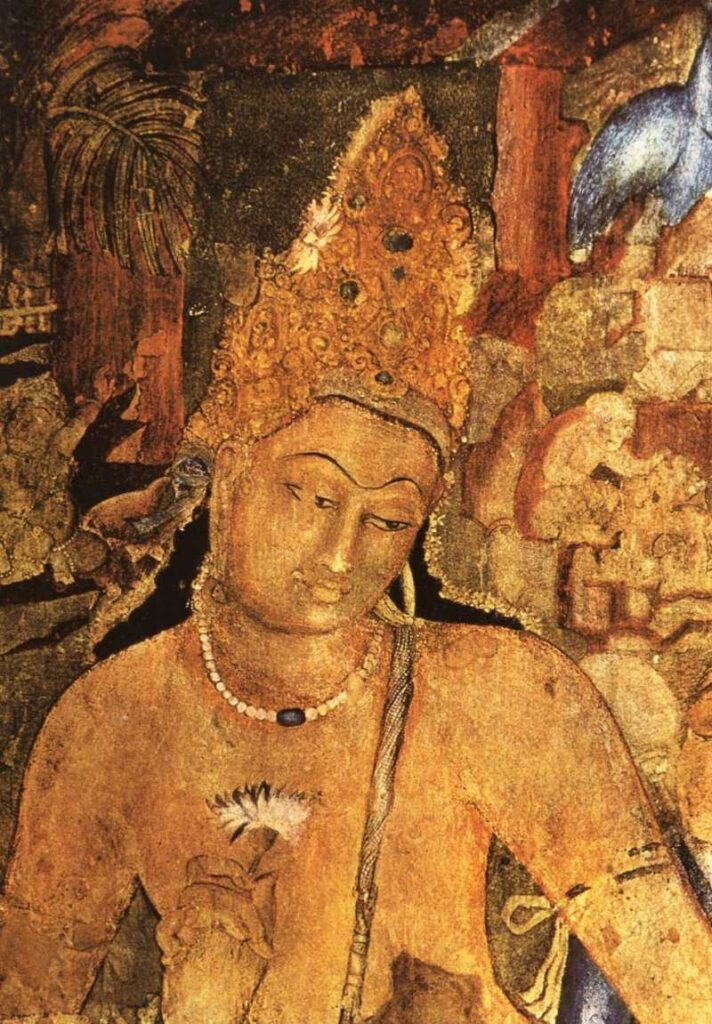There are different classifications of Indian Paintings like Mural paintings, Miniature paintings, etc. Mural paintings are works painted on walls or solid structures. They have existed in India since ancient times and can be dated between the 10th century BC and to 10th century AD. The evidence of these paintings can be found at several locations in India. Most of these paintings are found mostly in either cave or rock-cut chambers and they have common themes of Hindu, Buddhism, and Jainism.
The mural paintings are painted on large structures, usually caves and temple, they cannot be contained on paper because of their sheer size. Some of the best examples of mural paintings included; Ajanta caves, Ellora caves, Bagh cave, Sittanavasal cave etc.
Also Read : Indian Paintings – Principles and Pre-Historic Paintings
Paintings of Ellora and Ajanta Caves

The paintings of Ellora caves are based on themes of three religions; Hinduism, Jainism and Buddhism. Most of the paintings of Ellora are confined to the five caves of Kailasa Temple. The first phase of Ellora paintings was done when these caves were carved out and second phase was much later after many centuries. Images of Goddess Lakshmi and Lord Vishnu, Beautiful and gracious Apsaras, etc. are some examples of the Ellora cave paintings.

Ajanta cave paintings was carved around the 4th century AD. The caves of Ajanta have both murals and fresco (painted on wet plaster) paintings. The tempera style was used in these paintings. One unique feature of Ajanta caves is that each female figure has a unique hairstyle. The common themes of Ajanta caves were revolved around the Jataka stories (stories related to Buddha’s former lives as a Bodhisattva).
For example, Vajrapani, Manjushri, Padmapani, dying princess in cave no. 16, scene of Shibi Jataka, Matri-Poshaka Jataka etc. are the major examples of Ajanta paintings.
Other Important Mural Paintings in India
The Bagh caves in Madhya Pradesh are quite close to Ajanta caves in their design, execution and decoration. Rang Mahal, Jataka stories are examples of paintings of Bagh caves. The Arnamalai caves in Tamil Nadu, are natural caves but later converted to Jain temple. The tales of Astathik Palakas (deities protecting eight corners) and Jainism are examples of Arnamalai cave paintings.
Sittanavasal cave paintings in Tamil Nadu closely resemble Bagh and Ajanta paintings. In these caves, paintings were also found on ceiling and pillars with walls. The medium used to paint these paintings is vegetable and mineral dyes and is done by putting colors on the surface of thin wet lime plaster. A pond with lotuses was the central element of these paintings. The scenes of Samana-sarana (Jain tradition), Tirthankaras delivering sermons, etc. are popular paintings of Sittanavasal caves.
Ravan Chhaya Rock Shelter in Odisha and Lepakshi paintings in Andhra Pradesh are important sites of mural paintings in India. Some mural paintings belonging to the period of around 1000 BCE are found in Jogimara caves in Chhattisgarh. Mural paintings of Badami caves are one of the earliest Hindu paintings surviving. Shiva and Parvati, Puranic events and deities, etc. were the major examples of the Badami cave paintings.
Thus, mural paintings in India have different styles and different forms.

Pingback: Miniature Paintings – Techniques and Early Miniature -